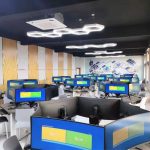Solution Overview
The vGPU Desktop Cloud Solution is a high-performance virtualization offering designed for schools specializing in design and architecture disciplines that rely on 3D design software and non-linear editing applications. The solution leverages a self-developed GPU virtualization technology (vGPU), enabling server-side GPU resources to be shared across all virtual machines. Each VM is allocated independent GPU resources, allowing precise partitioning of physical GPUs.
This architecture ensures smooth performance for resource-intensive applications such as Maya, 3ds Max, UG, and BIM software, meeting the high graphical processing demands of students and faculty in design-related programs. A unified web-based interface provides centralized management of labs, devices, and desktops—simplifying IT operations, improving classroom efficiency, and delivering a seamless teaching and learning experience.
Solution Architecture Diagram

Solution Details
- On-Demand Resource Allocation with Visualized Platform Management
Desktop resources are no longer statically bound. Based on application requirements, CPU, memory, and GPU resources can be flexibly assigned directly via the web-based management platform—for example, allocating 8 vCPUs, 16GB RAM, and 8GB GPU memory to specific desktops—to meet high-performance computing needs.
- GPU Sharing and Passthrough: Optimized for Teaching and Research
GPU Sharing Mode:Server-side GPU resources are virtualized and shared across multiple virtual machines, with each VM receiving independent GPU access. This approach allows for effective partitioning of physical GPU resources to support 3D modeling and rendering applications like Maya, 3ds Max, UG, and BIM. The number of users supported per server is dynamically adjusted based on system load.
GPU Passthrough Mode:In this 1:1 allocation model, a dedicated physical GPU is assigned to each virtual desktop. With OS-EASY’s virtualization technology, applications within the VM can directly utilize the GPU’s processing cores. This eliminates the abstraction overhead of GPU sharing and delivers near-native performance—ideal for research scenarios requiring maximum graphical computing power.
- Smart Encoding Engine for Enhanced Image Decoding Efficiency
Powered by the proprietary OEIDP protocol, the system uses AI-based dynamic region detection to refresh only changed screen areas, reducing data transmission. A smart graphics encoding engine accelerates decoding via GPU, reduces latency, and significantly enhances the user experience in graphic-intensive applications.
- Remote Access to GPU Desktops Anytime, Anywhere
Whether teaching in a multimedia classroom, working remotely, or unable to access the office, teachers can securely access their GPU-accelerated personal desktops anytime, anywhere using laptops or PCs via the OS-EASY client or a web browser.
- Student Mobile Access to Training Desktops via Laptops
Students can log into the “teaching desktop pool” from their personal laptops in public learning areas or open labs, enabling flexible, open-access experimental learning.
- Run Multiple Operating Systems Simultaneously in a Single Window
For emerging engineering and programming courses, students can run multiple operating systems (Linux, Windows 10, Windows 7, etc.) simultaneously within a single interface. They can switch between full-screen or multi-window modes according to need, allowing for efficient multitasking and seamless user experience.
- Role-Based Template Permissions with Instructor-Controlled Software Installation
After receiving teaching tasks, administrators can share OS template links with instructors, who can independently install subject-specific software, drivers, and tools via browser-based access.
- Unified Software Registration with High Activation Efficiency
With hardware virtualization, software only needs to be registered once within the system template. Upon large-scale deployment, re-registration is unnecessary for each instance—improving software registration efficiency by up to 90%.
Solution Value
- Superior 3D Experience
GPU virtualization (vGPU) enables the partitioning of physical GPU resources while maintaining full GPU functionality. It supports OpenGL, DirectX, and mainstream 3D design software, delivering a smooth and high-fidelity 3D user experience that meets the performance needs of graphics-intensive applications.
- On-Demand Resource Allocation, 2× Resource Utilization
Resources such as CPU, memory, and GPU can be flexibly allocated based on specific design user requirements. For example, when rendering large files, multi-core CPUs and high-memory desktops can be assigned to designated terminals—significantly boosting rendering performance and achieving elastic, efficient resource usage
- Efficient and Simplified O&M, 80% Improvement in Management Efficiency
While meeting the demands of 3D design software, the platform also provides a unified web-based interface for centralized operations and maintenance. Key features include lightning-fast bulk deployments, differential software updates, and multi-OS on-demand delivery—dramatically reducing IT workload and improving overall management efficiency.






